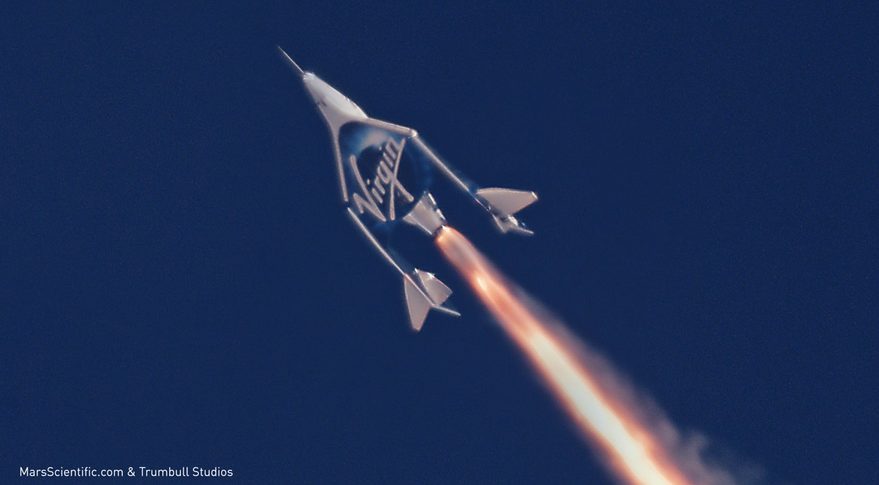
As Virgin Galactic gets closer to its first suborbital flights into space, a potential change in terminology could make it easier for the company to achieve that milestone.
In an interview with CNN published Nov. 30, Virgin Galactic founder Richard Branson said the company was within weeks of flying its SpaceShipTwo suborbital spaceplane into space. That vehicle, named VSS Unity, has been performing a series of powered test flights, most recently July 26.
“Space is difficult,” Branson said in response to a question that cited unnamed critics who didn’t believe the company would be able to reach space with SpaceShipTwo. “Obviously, we’d love to prove our critics wrong and I’m reasonably confident that, before Christmas, we will do so.”
Branson had suggested in an October interview with CNBC that the first flight into space by SpaceShipTwo would come in “weeks, not months.” Company officials at the time declined to comment on that schedule, sticking to a long-held policy of letting Branson set schedules and deadlines, although they indicated they planned to perform at least one more powered test flight before the end of the year.
George Whitesides, chief executive of Virgin Galactic, didn’t give a specific schedule in a Nov. 27 speech at the SpaceCom Expo in Houston, but did suggest that more, and higher altitude, test flights are coming soon. “The next few flights will be even more exciting” than the July flight, which reached a peak altitude of 52 kilometers, he said. “We’ll be seeing some of those soon.”
That July flight involved a 42-second burn of SpaceShipTwo’s hybrid rocket motor, which is designed to fire for about 60 seconds on a typical flight. “We’re at the place where we’re about to add a whole lot of apogee if we keep burning the rocket motor,” Whitesides said during a dinner talk at the Space Settlement Summit Nov. 2 in Los Angeles.
One question is what altitude SpaceShipTwo will need to reach in order to have considered to reach space. While there is no formal boundary of space in treaties or law, the industry has frequently used the altitude of 100 kilometers, known as Karman Line after the late aerospace engineer Theodore von Kármán. That definition gained prominence during the Ansari X Prize competition for commercial suborbital vehicles, won by SpaceShipOne in 2004 when it flew above that altitude twice within two weeks, as well as during a test flight three months earlier.
There’s been industry speculation, though, that SpaceShipTwo will not be able to achieve that altitude in its current configuration with a full payload of spaceflight participants or experiments on board. Whitesides, asked about altitudes in his Los Angeles talk, referenced instead a lower altitude used by the U.S. government.
“For Virgin Galactic, the major milestone that we perceive is the altitude at which NASA and Air Force folks get their astronaut wings, which is 50 miles,” he said. “For us and our customers, I think we’ll be focused on 50 miles, at least at the start.”
International bodies are now revisiting the Karman line definition. In a Nov. 30 statement, the Fédération Aéronautique Internationale (FAI), the world air sports federation that maintains records for both aviation and spaceflight, announced it would work with the International Astronautical Federation (IAF) to revisit what altitude should be considered the boundary of space for its record-keeping purposes.
“Recently published analyses present a compelling scientific case for reduction in this altitude from 100 km to 80 km,” the FAI said its statement. Eighty kilometers is approximately 50 miles. FAI said it proposed to the IAF that “an international workshop is held during 2019 to fully explore this issue with input and participation from the astrodynamics and astronautical community. “
The FAI statement didn’t mention the specific analyses that led it to reconsider the altitude of the Karman Line. One such paper, though, was published recently in the journal Acta Astronautica by Jonathan McDowell, an astronomer and spaceflight historian at the Harvard-Smithsonian Center for Astrophysics, who recommended lowering the Karman Line to 80 kilometers.
That paper, besides examining the historical record, featured an extensive mathematical analysis, modeling forces on a spacecraft traveling through the upper atmosphere. It concluded that, for most satellites, gravity exceeded aerodynamic forces at altitudes of 70 to 90 kilometers. “On the basis of these physical, technological and historical arguments, I therefore suggest that a value of 80 km is a more suitable choice to use as the canonical lower ‘edge of space’ in circumstances where such a dividing line between atmosphere and space is desired,” the paper concluded.
Whitesides referenced that paper in his comments last month. “If you look back at space history, it’s not at all clear that Kármán really thought that 100 [kilometers] was really the right place,” he said. “It’s sort of a nice round number.”
That dividing line has not been an issue for the other company pursuing a commercial human suborbital spaceflight system. Blue Origin’s New Shepard has exceeded 100 kilometers on several of its test flights, including the latest one July 18 where the vehicle’s crew capsule reached a peak altitude of about 119 kilometers thanks to the use of its abort motor shortly after separating from the vehicle’s propulsion module.